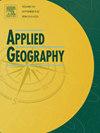Urban-rural disparities in the ecological impact of built-up land expansion: A comprehensive assessment from China
IF 4
2区 地球科学
Q1 GEOGRAPHY
引用次数: 0
Abstract
There is still a lack of systematic understanding on whether urban or rural settlement expansion has a greater impact on habitat quality. Here, we assessed the urban-rural disparities in the impact of built-up land expansion on habitat quality in China for the periods 2000–2020 and 2020–2050, using high-resolution land-use data and the PLUS-InVEST models. Our findings reveal that over the past two decades, built-up land expansion had significantly degraded habitat quality, and rural settlement expansion had a substantially greater negative impact on habitat quality compared to urban growth, particularly in areas with high rural population densities. The difference in impact is mainly attributed to the lack of unified planning in rural development, while urban follows strict, intensive, and green planning, with increasing emphasis on mitigating human activities’ impact on the eco-environment. Further projections indicate that the expansion rate of built-up land in China would slow down over the next 30 years, leading to a reduced impact on habitat quality. This study highlights the critical need for targeted policy measures to mitigate the ecological risks associated with rural expansion and provides valuable insights for more effective land-use planning and ecological conservation strategies. Our findings provide critical insights for optimizing land use strategies in China and offers a valuable framework for other developing countries.
建成区扩张生态影响的城乡差异:来自中国的综合评价
对于城市和农村住区扩张对栖息地质量的影响孰大孰小,目前还缺乏系统的认识。本文利用高分辨率土地利用数据和PLUS-InVEST模型,评估了2000-2020年和2020-2050年中国建成区扩张对栖息地质量影响的城乡差异。我们的研究结果表明,在过去的20年里,建成区扩张显著降低了栖息地质量,与城市增长相比,农村居民点扩张对栖息地质量的负面影响要大得多,特别是在农村人口密度高的地区。影响差异的主要原因是农村发展缺乏统一规划,而城市发展遵循严格、集约、绿色规划,越来越重视减轻人类活动对生态环境的影响。进一步的预测表明,中国建设用地的扩张速度将在未来30年放缓,导致对栖息地质量的影响减少。该研究强调了采取有针对性的政策措施以减轻农村扩张带来的生态风险的迫切需要,并为更有效的土地利用规划和生态保护战略提供了宝贵的见解。我们的研究结果为优化中国土地利用战略提供了重要见解,并为其他发展中国家提供了有价值的框架。
本文章由计算机程序翻译,如有差异,请以英文原文为准。
求助全文
约1分钟内获得全文
求助全文
来源期刊

Applied Geography
GEOGRAPHY-
CiteScore
8.00
自引率
2.00%
发文量
134
期刊介绍:
Applied Geography is a journal devoted to the publication of research which utilizes geographic approaches (human, physical, nature-society and GIScience) to resolve human problems that have a spatial dimension. These problems may be related to the assessment, management and allocation of the world physical and/or human resources. The underlying rationale of the journal is that only through a clear understanding of the relevant societal, physical, and coupled natural-humans systems can we resolve such problems. Papers are invited on any theme involving the application of geographical theory and methodology in the resolution of human problems.
 求助内容:
求助内容: 应助结果提醒方式:
应助结果提醒方式:


